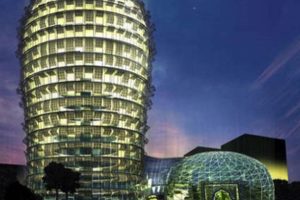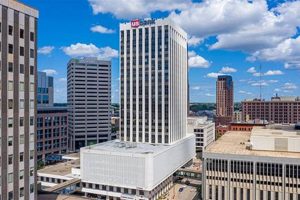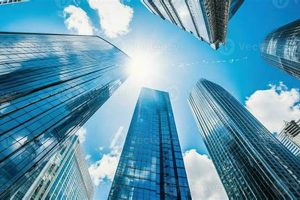Beneath towering skyscrapers, a critical component ensures the safety and comfort of occupants: the shock absorber. These devices, strategically positioned beneath the foundation, play a crucial role in mitigating vibrations and safeguarding the building’s structural integrity.
Shock absorbers, typically consisting of steel springs, hydraulic dampers, or a combination thereof, effectively absorb and dissipate energy from seismic activities, wind loads, and other dynamic forces. Their presence minimizes oscillations, preventing resonance that could potentially compromise the building’s stability. Moreover, they enhance occupant comfort by reducing perceptible vibrations, creating a more tranquil indoor environment.
The concept of shock absorbers under skyscrapers gained prominence following advancements in structural engineering and the increasing prevalence of high-rise buildings. Today, they are an indispensable component of modern skyscraper design, contributing to the safety, durability, and overall performance of these architectural marvels.
1. Vibration Reduction
Vibration reduction is a critical aspect of skyscraper design, where shock absorbers play a pivotal role. Vibrations, whether caused by wind, seismic activity, or other dynamic forces, can compromise the structural integrity of a building and diminish occupant comfort.
- Structural Stability: Shock absorbers dissipate energy from vibrations, preventing resonance that could potentially damage the building’s structure. This is especially crucial during seismic events, where uncontrolled vibrations can lead to catastrophic failures.
- Occupant Comfort: Excessive vibrations can cause discomfort and even nausea among occupants. Shock absorbers effectively reduce perceptible vibrations, creating a more tranquil and comfortable indoor environment.
- Acoustic Control: Vibrations can generate unwanted noise and sound disturbances. Shock absorbers mitigate these vibrations, contributing to a quieter and more serene indoor atmosphere.
- Long-Term Durability: Continuous vibrations can accelerate wear and tear on a building’s components. Shock absorbers reduce these vibrations, extending the lifespan of the building and its various systems.
In summary, vibration reduction is essential for ensuring the safety, comfort, and durability of skyscrapers. Shock absorbers, as key components in vibration control systems, play a vital role in achieving these objectives, showcasing the importance of engineering innovation in modern architecture.
2. Seismic Protection
In the realm of skyscraper engineering, seismic protection stands as a paramount concern, and shock absorbers play a pivotal role in safeguarding these towering structures against the destructive forces of earthquakes.
- Structural Stability: Shock absorbers serve as the first line of defense against seismic activity, effectively dissipating energy and minimizing the transfer of vibrations throughout the building’s structure. This helps maintain the building’s stability, preventing catastrophic failures.
- Base Isolation: Advanced shock absorbers, incorporated as part of a base isolation system, can decouple the building from the ground, significantly reducing the seismic forces transmitted to the structure. This innovative approach further enhances the building’s resilience to earthquakes.
- Tuned Mass Dampers: These specialized shock absorbers, strategically placed at the top of the building, counteract the resonant frequencies induced by earthquakes. By oscillating in opposition to the building’s motion, tuned mass dampers effectively reduce vibrations, safeguarding the structure’s integrity.
- Energy Dissipation: Shock absorbers dissipate the energy absorbed from seismic activity, preventing it from damaging the building’s components. This energy dissipation helps maintain the building’s structural integrity, ensuring the safety of occupants.
In conclusion, shock absorbers are indispensable components in the seismic protection of skyscrapers. Their ability to mitigate vibrations, isolate the structure from ground motion, and dissipate energy plays a crucial role in safeguarding these architectural marvels against the devastating effects of earthquakes.
3. Structural integrity
Structural integrity refers to the ability of a building to withstand external forces and maintain its stability. In the context of skyscrapers, shock absorbers play a pivotal role in preserving structural integrity, especially during dynamic events like earthquakes and high winds.
- Vibration Reduction: Shock absorbers effectively dampen vibrations induced by external forces, preventing resonance that could potentially compromise the building’s structural stability. Minimizing vibrations also reduces stress on the building’s components, extending its lifespan.
- Seismic Protection: Shock absorbers act as a buffer against seismic forces, dissipating energy and reducing the impact of ground motion on the building. This helps prevent structural damage and ensures the safety of occupants during earthquakes.
- Wind Resistance: High-rise buildings are susceptible to wind-induced vibrations, which can cause discomfort and even structural damage. Shock absorbers mitigate these vibrations, enhancing the building’s wind resistance and overall stability.
- Base Isolation: Advanced shock absorbers, incorporated as part of a base isolation system, can significantly reduce the seismic forces transmitted to the building. By isolating the structure from the ground, base isolation systems minimize structural damage and preserve the building’s integrity.
In conclusion, shock absorbers play a crucial role in maintaining the structural integrity of skyscrapers. Their ability to dampen vibrations, mitigate seismic forces, enhance wind resistance, and enable base isolation systems ensures the safety and stability of these architectural marvels.
4. Occupant comfort
Occupant comfort is a crucial aspect of skyscraper design, and shock absorbers play a significant role in achieving this objective. Vibrations caused by wi
nd, seismic activity, and other dynamic forces can adversely affect occupant comfort, causing discomfort, nausea, and even health issues.
Shock absorbers effectively mitigate these vibrations, creating a more tranquil and comfortable indoor environment. They reduce perceptible vibrations, minimizing the potential for discomfort and ensuring the well-being of occupants. This is especially important for high-rise buildings, where occupants may be more sensitive to vibrations due to the building’s height and exposure to wind forces.
Incorporating shock absorbers into skyscraper design not only enhances occupant comfort but also contributes to the building’s overall functionality. Reduced vibrations create a more conducive environment for work, rest, and leisure activities, improving the quality of life for occupants. Moreover, it can positively impact productivity and reduce absenteeism, contributing to the building’s overall success.
5. Durability
Durability is a critical aspect of skyscraper construction, and shock absorbers play a significant role in enhancing the longevity and resilience of these towering structures. Skyscrapers are subjected to various dynamic forces, including wind, seismic activity, and human-induced vibrations, which can compromise their structural integrity over time. Shock absorbers serve as a line of defense against these forces, safeguarding the building’s structural components and ensuring its long-term stability.
Shock absorbers effectively dissipate energy from vibrations, preventing resonance that could potentially damage the building’s structure. By reducing stress and strain on structural elements, shock absorbers extend the lifespan of the building and minimize the need for costly repairs or renovations. Moreover, they contribute to occupant safety by mitigating the effects of earthquakes and other dynamic events.
The durability of shock absorbers themselves is crucial to the overall performance of the building. High-quality shock absorbers are designed to withstand the rigors of continuous use and exposure to harsh environmental conditions. They are typically made from durable materials such as steel, rubber, and advanced composite materials that can withstand extreme temperatures, moisture, and corrosive elements. Regular maintenance and inspection of shock absorbers are essential to ensure their optimal functionality and extend their lifespan.
In summary, shock absorbers are essential components of skyscrapers, contributing to their durability and long-term performance. By mitigating vibrations, reducing stress on structural elements, and ensuring occupant safety, shock absorbers play a vital role in maintaining the integrity and functionality of these architectural marvels.
6. Building performance
In the realm of skyscraper engineering, building performance encompasses a wide range of factors that contribute to the overall functionality, safety, and sustainability of these architectural marvels. Shock absorbers, strategically positioned beneath skyscrapers, play a crucial role in enhancing building performance, ensuring the structural integrity, occupant comfort, and long-term durability of these towering structures.
- Vibration Control: Shock absorbers effectively mitigate vibrations caused by wind, seismic activity, and other dynamic forces, preventing resonance that could potentially damage the building’s structure. This vibration control contributes to enhanced building performance by safeguarding the structural integrity and ensuring occupant comfort.
- Seismic Protection: Shock absorbers serve as the first line of defense against seismic forces, dissipating energy and reducing the impact of ground motion on the building. This seismic protection plays a critical role in ensuring the safety and stability of skyscrapers during earthquakes, minimizing structural damage and protecting occupants.
- Wind Resistance: High-rise buildings are susceptible to wind-induced vibrations, which can cause discomfort and even structural damage. Shock absorbers mitigate these vibrations, enhancing the building’s wind resistance and overall stability. This improved wind resistance contributes to better building performance, reducing the risk of structural damage and ensuring occupant safety.
- Durability and Longevity: Shock absorbers extend the lifespan of a building by reducing stress and strain on structural elements, preventing premature deterioration and costly repairs. This enhanced durability contributes to long-term building performance, ensuring the skyscraper remains safe, functional, and aesthetically pleasing for generations to come.
In conclusion, shock absorbers are essential components that significantly enhance building performance in skyscrapers. Their ability to control vibrations, provide seismic protection, improve wind resistance, and enhance durability makes them indispensable for the structural integrity, occupant comfort, and long-term functionality of these architectural marvels.
7. Engineering Innovation
Engineering innovation plays a pivotal role in the design and implementation of shock absorbers for skyscrapers. These architectural marvels require advanced solutions to withstand dynamic forces and ensure the safety and comfort of occupants. Here are key facets of engineering innovation in this context:
- Advanced Materials: Engineers leverage cutting-edge materials like shape memory alloys, carbon fiber composites, and high-strength steel to create shock absorbers with exceptional damping capacity, durability, and corrosion resistance.
- Smart Systems: Shock absorbers are integrated with sensors and control systems that monitor vibrations and adjust damping properties in real-time. This adaptability enhances performance and ensures optimal protection against dynamic loads.
- Computational Modeling: Advanced computational modeling techniques allow engineers to simulate the dynamic behavior of shock absorbers and optimize their design for specific skyscraper configurations and environmental conditions.
- Hybrid Systems: Engineers combine different types of shock absorbers, such as viscous dampers, tuned mass dampers, and base isolation systems, to create hybrid systems that provide comprehensive protection against a wide range of dynamic forces.
These engineering innovations have revolutionized the design of shock absorbers for skyscrapers, enabling the construction of taller, more resilient, and more comfortable buildings that can withstand the challenges of modern urban environments.
FAQs on Shock Absorbers in Skyscrapers
Shock absorbers play a crucial role in the safety and performance of skyscrapers. Here are answers to some frequently asked questions about these essential components:
Question 1: What is the purpose of shock absorbers in skyscrapers?
Shock absorbers mitigate vibrations caused by wind, earthquakes, and other dynamic forces. They protect the building’s structural integrity, enhance occupant comfort, and extend the bui
lding’s lifespan.
Question 2: How do shock absorbers work in skyscrapers?
Shock absorbers dissipate energy from vibrations through damping mechanisms. They typically consist of steel springs, hydraulic dampers, or a combination of both, effectively absorbing and reducing vibrations.
Question 3: Are shock absorbers necessary for all skyscrapers?
Yes, shock absorbers are essential for skyscrapers, particularly for high-rise buildings. They play a critical role in ensuring structural stability, occupant comfort, and long-term durability.
Question 4: What are the different types of shock absorbers used in skyscrapers?
Common types of shock absorbers include viscous dampers, tuned mass dampers, and base isolation systems. Each type has unique characteristics and is selected based on the specific design and requirements of the skyscraper.
Question 5: How are shock absorbers maintained in skyscrapers?
Regular maintenance and inspections are crucial to ensure the optimal performance of shock absorbers. This involves monitoring their condition, replacing worn-out components, and fine-tuning their damping properties.
Question 6: How have advancements in technology influenced shock absorbers in skyscrapers?
Technological advancements have led to the development of innovative materials and smart systems for shock absorbers. These advancements enhance damping capacity, adaptability, and overall performance, contributing to the safety and efficiency of modern skyscrapers.
Understanding the role and importance of shock absorbers in skyscrapers is essential for appreciating the engineering marvel behind these architectural wonders.
Transition to the next article section: Engineering Marvels: The Role of Shock Absorbers in Skyscrapers
Tips for Optimizing Shock Absorber Performance in Skyscrapers
To ensure the optimal performance of shock absorbers in skyscrapers, consider the following tips:
Tip 1: Choose the Right Type of Shock Absorber
Select the most appropriate shock absorber type (e.g., viscous damper, tuned mass damper, base isolation system) based on the skyscraper’s design, height, and specific requirements.
Tip 2: Proper Installation and Maintenance
Ensure precise installation and regular maintenance of shock absorbers to guarantee their effectiveness and longevity. Regular inspections and timely replacement of worn components are crucial.
Tip 3: Consider Environmental Factors
Account for environmental factors such as temperature variations, wind loads, and seismic activity when selecting and designing shock absorbers. This ensures they can withstand the expected dynamic forces.
Tip 4: Integrate with Building Management Systems
Integrate shock absorbers with the building’s management systems to enable real-time monitoring and control. This allows for adjustments to damping properties based on changing conditions.
Tip 5: Utilize Advanced Materials and Technologies
Incorporate advanced materials (e.g., shape memory alloys, carbon fiber composites) and technologies (e.g., smart sensors, computational modeling) to enhance the performance and durability of shock absorbers.
Tip 6: Conduct Regular Performance Evaluations
Perform regular performance evaluations of shock absorbers to assess their effectiveness and identify any potential issues. This helps ensure they continue to meet the required performance standards.
Tip 7: Seek Expert Advice
Consult with experienced engineers and specialists in the field of shock absorber design and implementation for skyscrapers. Their expertise can guide optimal decision-making.
Tip 8: Consider Long-Term Performance and Sustainability
Envision the long-term performance and sustainability of shock absorbers. Choose durable materials, implement proper maintenance practices, and consider energy-efficient designs to ensure their effectiveness throughout the building’s lifespan.
By following these tips, you can optimize the performance of shock absorbers in skyscrapers, ensuring the safety, comfort, and longevity of these architectural marvels.
Transition to the article’s conclusion: Conclusion: The Significance of Shock Absorbers in Skyscrapers
Conclusion
Shock absorbers play a pivotal role in the safety, comfort, and longevity of skyscrapers. Their ability to mitigate vibrations, protect against seismic forces, and enhance overall building performance is essential for these architectural marvels to withstand dynamic forces and provide a comfortable living and working environment.
As skyscrapers continue to soar higher and become more complex, the demand for innovative and effective shock absorbers will only increase. Engineers and architects must continuously explore new materials, technologies, and design approaches to optimize the performance of these critical components. By doing so, we can ensure that skyscrapers remain safe, sustainable, and awe-inspiring symbols of human ingenuity.







